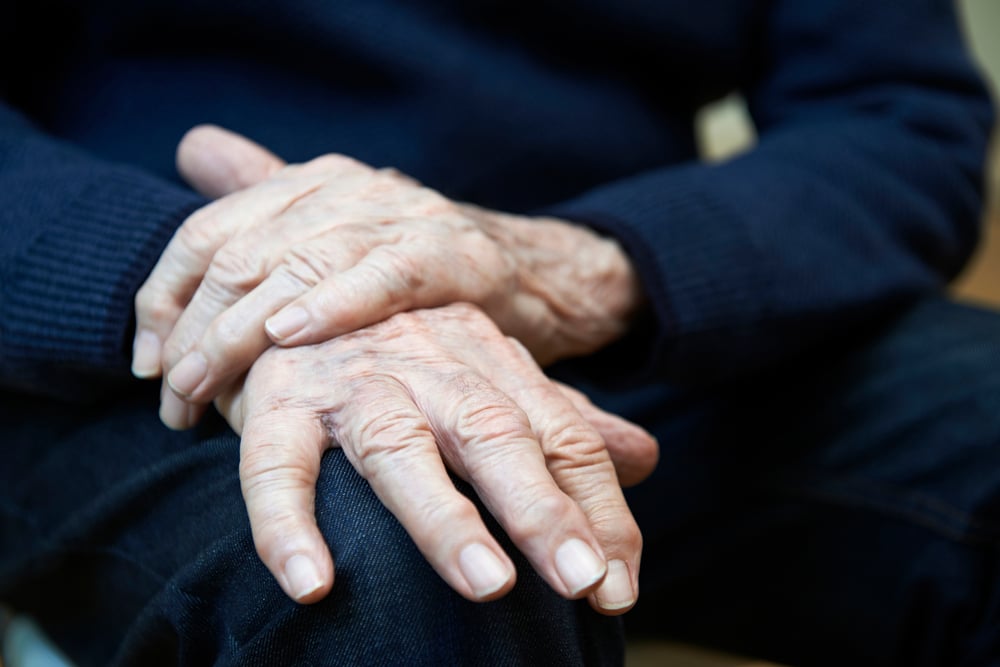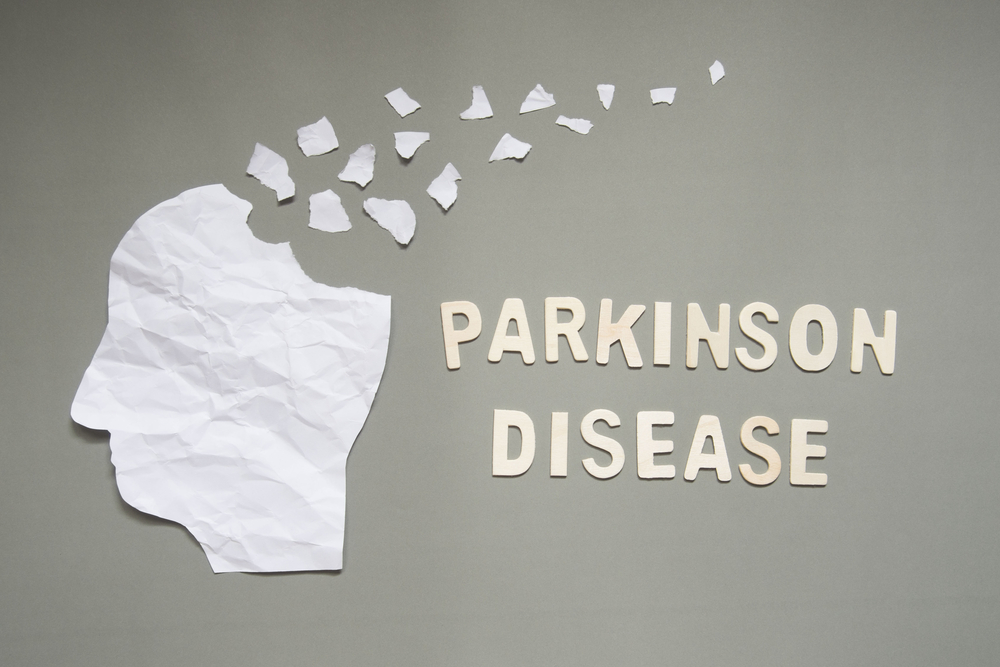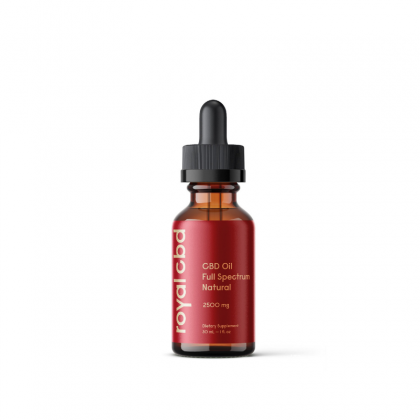| Total CBD: | 500 – 2500 mg |
| Potency: | 16.6 - 83.3 mg/mL |
| Cost per mg CBD: | $0.12 – $0.18 |
| Extract Type: | Full-spectrum |
| THC Content: | <0.3% |
Evidence based
CBD Oil For Parkinson's Disease: Best Products, Safety, & Dosage
Parkinson’s disease is an incurable neurodegenerative disorder.
Evidence suggests CBD may be able to provide relief from some of the most irritating symptoms.
Here’s how it works.
Parkinson’s disease is the second most common neurodegenerative disorder, behind Alzheimer’s disease. The condition affects an estimated 10 million people worldwide — primarily men over the age of 60.
Parkinson’s disease is characterized by muscle tremors, stiffness, and issues with movement.
Although there is no cure for Parkinson’s disease, the progression of the disease can be delayed with carefully orchestrated changes to the diet, lifestyle habits, and the use of medications and supplements.
New research suggests CBD oil may offer powerful support for common side-effects of Parkinson’s disease.
Here, we’ll discuss the best CBD oils for Parkinson’s disease, what dosage to use, and what side-effects to watch out for.

What Are The Benefits Of CBD For Parkinson’s Disease?
There is no cure for Parkinson’s disease — treatment is aimed at slowing the progression of the disease and managing uncomfortable symptoms as they appear in order to improve quality of life.
Parkinson’s patients use CBD supplements to help alleviate symptoms such as depression, anxiety, muscle tremors, and some of the other complications associated with the condition.
There’s also some indication that CBD can be used to slow the progression of the disease and improve underlying factors including brain inflammation and dopamine regulation.
The potential benefits CBD oil for Parkinson’s Disease Include:
- Reduces brain inflammation
- Alleviates muscle tremors
- Supports depression & mood disorders
- Improves sleep quality & duration
- May support dopamine production
- Supports healthy microbiome diversity
1. Reduces Brain Inflammation
Inflammation in the brain is closely associated with Parkinson’s disease [6]. As damage occurs in the dopamine-producing neurons in the brain, inflammation gradually worsens. As inflammation intensifies, it speeds up the neurodegenerative processes in the brain — aggravating the condition.
Inflammation may or may not be an underlying cause for Parkinson’s, we still don’t know for sure. What we do know, however, is that this form of inflammation isn’t making the condition any better. Therefore one of the primary treatments for this condition is to try and lower inflammation in the brain. This helps the neurons recover, and may slow the progression of the disorder.
CBD is especially proficient at addressing inflammation in the brain as it mediates several key pathways involved with the inflammatory process [7].
Inflammation in the brain is thought to be one of the main perpetuating factors of Parkinson’s disease [6].
2. May Reduce Muscle Tremors
Muscle tremors are one of the primary symptoms of Parkinson’s disease. It has a major impact on the quality of life of those affected.
CBD has shown promise in early research to variably improve muscle tremors in mice with Parkinson’s disease [8], and similar potential neurodegenerative disorders like multiple sclerosis (MS) [9], and Huntington’s disease [10] — all worth further clinical investigation.
3. May Alleviate Depression
Studies suggest that 45% of people with Parkinson’s disease also suffer from depression [2, 3].
One of the most important benefits of CBD is in the potential relief of depression. The main mechanism CBD is thought to relieve symptoms of depression is through its ability to reduce neuroinflammation [17] — a condition that’s also present with many Parkinson’s disease patients and is likely a contributor to so many Parkinson’s patients also suffer from depression.
4. Improves Sleep Quality and Onset
Sleep disorders are a common side-effect of Parkinson’s disease [13].
There are several reasons for this, including:
- Involuntary muscle movements sleeping
- Muscle contractions in the early hours of the morning
- Painful cramps at night
- Tremor and difficulty turning in bed
- Medication side-effects (such as levodopa, other dopamine agonists and antidepressants)
- Hallucinations
- Vivid dreams
CBD is well-known for its mild sedative benefits [11]. CBD improves both sleep quality and quantity in a series of clinical trials [12].
Other cannabinoids, including CBG (cannabigerol), are thought to offer muscle relaxant properties — adding layers of support for some of the primary causes of insomnia among Parkinson’s disease [14].
5. Supports Dopamine Production
The primary cause of symptoms with Parkinson’s disease is low dopamine production in the brain. Therefore, one of the most important targets of effective treatment is on the dopamine-producing neurons in the brain.
CBD has been shown — in at least one preclinical study — to improve dopamine production [15]. It works through a newly discovered receptor known as the GPR6 receptors located in the same region where dopamine is manufactured [16].
This is a new and very important discovery. New research is currently underway to understand these effects in more detail and better discern the role CBD could possibly play in the role of Parkinson’s management.
If these findings are shown to be therapeutically relevant through future research, we can expect to see CBD become a primary treatment option for Parkinson’s disease. At this point, the research is inconclusive.
What’s the Recommended Dose of CBD?
There aren’t enough clinical studies to highlight a specific dosage range for Parkinson’s disease. However, there’s a lot of research on the use of CBD use for other neurodegenerative diseases, such as multiple sclerosis.
Heavy doses of CBD are usually required to produce benefits for these conditions.
We recommend starting at the low-strength dose as highlighted in the chart below and build up over time to the heavy dose based on your weight. To find your dose, use the CBD oil dosage calculator below.
For Parkinson’s disease, you should aim to use the supplement long-term.
Recommended Strength For Parkinson’s Disease: Heavy Strength
CBD Oil Dosage Calculator
What is Parkinson’s Disease (PD)?
Parkinson’s disease (PD) is a neurodegenerative disorder affecting the part of the brain responsible for manufacturing dopamine. Dopamine is a neurotransmitter associated with things such as mood, hormone balance, motor function, and focus or attention.
Symptoms of this condition usually appear gradually over the course of several years before and after diagnosis.
They begin with nonspecific issues like hyposmia (reduced sense of smell), sleep disorders, constipation, and obesity up to 20 years before the more characteristic muscular issues such as rigidity, tremors, and falling.
As the disease progresses, non-motor symptoms such as hallucinations, delusions, dementia, and depression can appear and worsen over the next 20 years.
Parkinson’s disease by itself isn’t considered fatal — however, some of the complications brought on by the disease are — and can also certainly be life-altering and devastating for patients and families.
A common finding in PD patients is an abundance of Lewy bodies — clusters of proteins inside the neurons that don’t break down as they should through normal enzyme reactions in the brain.
As these Lewy bodies become more abundant and build up, they kill the neurons. This type of neuron injury is also characteristic of other neurodegenerative disorders including Alzheimer’s disease (AD). The main differences are in the composition and location of the proteins.
In the case of Parkinson’s, the majority of these protein clusters are in the basal ganglia of the brainstem — specifically in the substantia nigra pars compacta neurons.

What Are The Signs & Symptoms of Parkinson’s Disease?
- Muscle tremors
- Bradykinesia
- Limb rigidity
- Mask-like face
- Gait and balance problems, i.e. shuffling
- Depression
- Poor focus or concentration
- Mood changes
- Apathy
- Constipation
- Excess salivation
- Urinary retention
- Sleep behavior disorders
- Loss of sense of smell
- Cognitive impairment
Dopamine & Parkinson’s Disease
The majority of symptoms associated with Parkinson’s disease result from a loss of dopamine-producing cells in the brainstem.
As the dopamine-producing neurons in the brainstem are lost, it becomes more difficult to manufacture the dopamine the brain needs to function properly. In fact, by the time characteristic muscle symptoms are clinically apparent, over 80% of the dopamine-producing neurons are gone. Without enough dopamine, symptoms like muscle tremors, lockjaw, weakness in the arms and legs, and poor balance are more frequent.
A loss of dopamine is linked with symptoms including:
- Mood changes
- Loss of normal muscle control
- Hormonal changes
- Poor libido
- Difficulty concentrating
- Depression
Norepinephrine & Parkinson’s Disease
Norepinephrine and epinephrine is structurally similar to dopamine and is built through the same pathway as dopamine. Therefore, epinephrine levels also suffer a decrease in production from Parkinson’s disease [1].
These neurotransmitters are major players in the sympathetic nervous system. As they start to become less abundant in the brain and blood vessels, we lose the ability to regulate autonomic functions including heart rate and blood pressure.
A loss of norepinephrine and/or epinephrine are linked with symptoms including:
- Fatigue
- Changes in blood pressure
- Problems with digestion
- Poor concentration
- Depression
What Causes Parkinson’s Disease?
The cause for Parkinson’s disease is still unknown — however, there are a few factors that we now know contribute to the condition over time.
Older studies used to report Parkinson’s disease as being non-hereditary — meaning a disease that isn’t passed on through genes [4]. Newer studies, however, found at least two gene variants related to Parkinson’s disease [5] — LRRK2 and GBA genes, albeit rarely. Most cases by far are idiopathic.
Some factors believed to be linked with Parkinson’s disease include:
- Heavy metal exposure
- Traumatic head injuries
- Genetic factors
- Paraquat exposure (pesticide)
- Leaky gut syndrome
- Poor microbiome diversity
- Mitochondrial disease

The 5 Stages of Parkinson’s Disease
Stage 1
Symptoms appear but are mild in nature. They usually don’t interfere with daily activities. The most common symptoms to appear are postural changes, muscle tremors, and changes in facial expression.
Stage 2
Stage two involves an increase in the severity of symptoms discovered in stage one and the development of symptoms affecting movement. It may be more difficult to walk normally, maintain correct posture, and normal tasks begin to become difficult. Usually, people in stage two don’t require outside assistance.
Stage 3
This stage is characterized by problems with maintaining balance and difficulties with day-to-day activities such as eating, using the toilet, or getting dressed. People in stage three may need assistance, while others remain independent.
Stage 4
By stage four, symptoms have become pronounced. Standing is possible, but walking requires the support of a walker or another person. Daily activities such as eating, bathing, and moving around require assistance. People at this stage are not able to live independently.
Stage 5
This is the last stage of Parkinson’s disease progression. Patients are unable to stand or walk on their own and are usually confined to a bed or wheelchair. Hallucinations and delusions may appear during this stage. Full-time assistance is required for people in this stage of disease.
How is Parkinson’s Disease Treated?
Most of the treatments for Parkinson’s disease are aimed at managing symptoms in order to optimize a patient’s quality of life. There are several medications and supplements that improve dopamine production in the brain, but these won’t cure the condition — only reduce the severity of symptoms associated with low dopamine. The medications will also need to be readjusted over time, along with regular follow ups with a neurologist.
Treatment Options for Parkinson’s Disease and Symptoms Includes:
- Amantadine
- Anticholinergic drugs
- Antidepressants (SNRIs, SSRIs, TCAs)
- Antioxidant supplementation
- Cardio-aerobic exercise
- Coffee consumption
- COMT inhibitors
- Deep brain stimulation
- Dopaminergic medications (MAO-B Inhibitors, amphetamines)
- Ensure adequate, restful sleep each night
- High fiber diets
- L-dopa supplementation
- Meditation/yoga/Tai-chi
- Occupational therapy
- Probiotic supplementation
- Speech therapy

Key Takeaways: Can CBD Help With Parkinson’s Disease?
There’s no cure for Parkinson’s disease — most of the treatment options available, including CBD are used to slow the progression of the disease and manage symptoms to improve a patient’s quality of life.
CBD is a potentially excellent option for both — it may alleviate many of the most common side-effects of the conditions (insomnia, depression, anxiety, muscle tremors) and perhaps may slow the progression of Parkinson’s, although more clinical research is needed to demonstrate this.
It’s important to consult with your doctor before using CBD to ensure it won’t have any negative interactions with the medications you’re taking. Patients with Parkinson’s disease will need multifaceted treatment and regular follow ups with their neurologist to readjust medication as needed.
Anecdotally, Most Parkinson’s patients use a high dose of CBD for long periods of time.
For maximum benefits, opt for a high-potency full-spectrum CBD oil to take advantage of other cannabinoids such as CBG that have their own set of benefits to offer Parkinson’s symptoms.
We also recommend using only high-quality CBD and hemp oils. Low-quality products may be contaminated with heavy metals or pesticides that can actually make symptoms even worse.
Always do your research before buying CBD to make sure the companies you’re buying from use high-quality hemp, free from contaminants.
Tips for Getting the Most Out of CBD Supplementation for Parkinson’s Disease
- Choose a full-spectrum extract — other cannabinoids in the cannabis plant offer separate benefits to this condition
- Always choose a high-quality, certified organic CBD supplement — poor quality products are often contaminated with heavy metals, pesticides, or mold that can be neurotoxic
- Be consistent with dosing — it can take several weeks of regular use notice the benefits of the supplement.
- Always consult with your doctor before taking CBD — some medications may have a negative interaction with the supplement
References Cited In This Article
- Delaville, C., De Deurwaerdère, P., & Benazzouz, A. (2011). Noradrenaline and Parkinson’s disease. Frontiers in systems neuroscience, 5, 31.
- Lemke, M. R. (2002). Effect of reboxetine on depression in Parkinson’s disease patients. The Journal of clinical psychiatry, 63(4), 300-304.
- Lemke, M. R., Fuchs, G., Gemende, I., Herting, B., Oehlwein, C., Reichmann, H., … & Volkmann, J. (2004). Depression and Parkinson’s disease. Journal of Neurology, 251(6), vi24-vi27.
- Jankovic, J., & Tolosa, E. (Eds.). (2007). Parkinson’s disease and movement disorders. Lippincott Williams & Wilkins.
- Ozelius, L. J., Senthil, G., Saunders-Pullman, R., Ohmann, E., Deligtisch, A., Tagliati, M., … & Lipton, R. B. (2006). LRRK2 G2019S as a cause of Parkinson’s disease in Ashkenazi Jews. New England Journal of Medicine, 354(4), 424-425.
- Hirsch, E. C., & Hunot, S. (2009). Neuroinflammation in Parkinson’s disease: a target for neuroprotection?. The Lancet Neurology, 8(4), 382-397.
- Baker, D., Jackson, S. J., & Pryce, G. (2007). Cannabinoid control of neuroinflammation related to multiple sclerosis. British journal of pharmacology, 152(5), 649-654.
- Kluger, B., Triolo, P., Jones, W., & Jankovic, J. (2015). The therapeutic potential of cannabinoids for movement disorders. Movement disorders, 30(3), 313-327.
- Malfitano, A. M., Proto, M. C., & Bifulco, M. (2008). Cannabinoids in the management of spasticity associated with multiple sclerosis. Neuropsychiatric disease and treatment, 4(5), 847.
- Dowie, M. J., Howard, M. L., Nicholson, L. F. B., Faull, R. L. M., Hannan, A. J., & Glass, M. (2010). Behavioural and molecular consequences of chronic cannabinoid treatment in Huntington’s disease transgenic mice. Neuroscience, 170(1), 324-336.
- Crippa, J. A., Guimarães, F. S., Campos, A. C., & Zuardi, A. W. (2018). Translational Investigation of the Therapeutic Potential of Cannabidiol (CBD): Toward a New Age. Frontiers in Immunology, 9. https://doi.org/10.3389/FIMMU.2018.02009
- Russo, E. B., Guy, G. W., & Robson, P. J. (2007, August 1). Cannabis, pain, and sleep: Lessons from therapeutic clinical trials of sativexρ, a cannabis-based medicine. Chemistry and Biodiversity. Wiley-Blackwell. https://doi.org/10.1002/cbdv.200790150
- Sleep disorders in Parkinson’s disease: Diagnosis and management. Ann Indian Acad Neurol. 2011;14(Suppl 1):S18-20.
- Evans, F. J. (1991). Cannabinoids: the separation of central from peripheral effects on a structural basis. Planta medica, 57(S 1), S60-S67.
- Morales, P., Isawi, I., & Reggio, P. H. (2018). Towards a better understanding of the cannabinoid-related orphan receptors GPR3, GPR6, and GPR12. Drug metabolism reviews, 50(1), 74-93.
- Laun, A. S., & Song, Z. H. (2017). GPR3 and GPR6, novel molecular targets for cannabidiol. Biochemical and biophysical research communications, 490(1), 17-21.
- Benatti, C., Blom, J.M., Rigillo, G., Alboni, S., Zizzi, F., Torta, R., Brunello, N., & Tascedda F. (2016) Disease-Induced Neuroinflammation and Depression. CNS & Neurological Disorders Drug Targets, 15(4), 414-33.
More Health Benefits to Explore
-
Conditions Related to Health Benefits
- CBD For Allergies: Can This Cannabinoid Ease Symptoms?
- Top 10 CBD Oils For Back Pain
- Can CBD Help With Menstrual Cramps?
- CBD for Sciatica: How It Works, Safety, Drug Interactions, & Best Products
- Is CBD a Viable Treatment for Cerebral Palsy?
- CBD Oil For Sleep
- CBD For Psoriasis: Can CBD Help to Alleviate Symptoms?
- Traumatic Brain Injury (TBI)
- Arthritis
- Anxiety & Depression
- Weight Loss
- ADD & ADHD
- Anorexia
- Alzheimer’s Disease & Dementia
- Addiction
- ALS (Amyotrophic Lateral Sclerosis)
- Antibiotic Resistance
- Asthma
- Atherosclerosis
- Autism
- Acne
- Bipolar Disorder
- Pain
- Crohn's Disease & Ulcerative Colitis
- Diabetes
- Epilepsy
- Endocrine Disorders
- Fibromyalgia
- Fatty Liver Disease
- Glaucoma
- Hypertension
- Heart Disease
- Huntington's Disease
- Inflammation
- Irritable Bowel Syndrome (IBS)
- Kidney Disease
- Migraine Headaches
- Muscle Recovery
- Multiple Sclerosis
- Motion Sickness
- Metabolic Syndrome
- Neurodegeneration
- Cancer
- Nausea
- Neuropathic (Nerve) Pain
- Osteoporosis/Bone Health
- Obsessive-Compulsive Disorder (OCD)
- Polycystic Ovarian Syndrome (PCOS)
- PTSD
- Prion/Mad Cow Disease
- Premenstrual Syndrome (PMS)
- Parkinson’s Disease
- Schizophrenia
- Sickle Cell Anemia
- Stroke
-
Conditions Related to Products
- Ranking The Top 13 THC Gummies By Category (Δ8, Δ9, Δ10, HHC, & More)
- Top 10 CBD Oils For Back Pain
- Everything You Need to Know About CBD Sunscreen
- Top 7 CBD Gummies For Sleep & Insomnia
- Top 7 CBD Gummies To Help With Anxiety (2022)
- Best CBD Gummies For Pain (Top-Rated Pain Gummies For 2022)
- Best Hemp Cigarettes (Top 5 Nicotine-Free Smokes)
- Top 5 CBD Lip Balms For 2022
- The Top 7 CBD Face Masks for 2022
- The Best CBD Inhalers For 2022 (& How to Use Them)
- Best Full-Spectrum CBD Vape Juice: What to Look For & How to Use It
- CBD Eye Drops: New Option For Glaucoma?
- CBD Oil For Dogs With Arthritis
- Best CBD Massage Oils In 2022
- Buyer's Guide To The Best CBD Vape Kits In 2022
- CBD Chocolate: Yes, It Exists & It's Just as Divine as it Sounds
- CBD Pre-Rolls & Cigarettes
- Terpene Concentrates
- Best CBD Soaps
- Best CBD Shampoo & Conditioner
- Best CBD Juul Pods
- CBD Isolate Oils
- Full-Spectrum CBD Oils
- Best CBD Lube
- CBD Honey
- CBD Transdermal Patches
- Best Dry Herb Vaporizers
- CBD Oil For Dogs With Epilepsy
- CBD Oil For Dogs With Anxiety
- CBD Oil For Dogs With Cancer
- CBD For Horses
- CBD Chewing Gum
- CBD Pain Cream
- CBD Oil For Cats
- CBD Oil For Dogs
- CBD Hemp Flower
- CBD Suppositories
- Best CBD Gummies for Pain, Sleep & Anxiety Reviewed (2022)
- CBD Teas
- CBD Vape Pens
- CBD Vape Oils
- CBD Coffee
- CBD Drinks & Shots
- CBD Crystals
- CBD Skincare
- Best CBD Oil & Gummies For Kids: Is CBD Safe for Children with Anxiety & ADHD?
- CBD Concentrates
- CBD Bath Bombs
- CBD Capsules
- CBD Sprays
- CBD Dog Treats
-
Conditions Related to Topicals
-
Conditions Related to Oils & Tinctures
-
Conditions Related to Edibles
- Top 7 CBD Gummies To Help With Anxiety (2022)
- Best CBD Gummies For Pain (Top-Rated Pain Gummies For 2022)
- CBD Chocolate: Yes, It Exists & It's Just as Divine as it Sounds
- CBD Honey
- CBD Chewing Gum
- Best CBD Gummies for Pain, Sleep & Anxiety Reviewed (2022)
- CBD Teas
- CBD Coffee
- CBD Drinks & Shots
- CBD Capsules
-
Conditions Related to Gummies
- Ranking The Top 13 THC Gummies By Category (Δ8, Δ9, Δ10, HHC, & More)
- Top 7 CBD Gummies For Sleep & Insomnia
- Top 7 CBD Gummies To Help With Anxiety (2022)
- Best CBD Gummies For Pain (Top-Rated Pain Gummies For 2022)
- Best CBD Gummies for Pain, Sleep & Anxiety Reviewed (2022)
- Best CBD Oil & Gummies For Kids: Is CBD Safe for Children with Anxiety & ADHD?
-
Conditions Related to Hemp Flower
-
-
Conditions Related to Terpenes
-
-
Conditions Related to Cultivation
-
Conditions Related to Concentrates
-
Conditions Related to Delta 8 THC
-
Conditions Related to Delta 9 THC
-
-
-
-
Conditions Related to CBD
- Everything You Need to Know About CBD Sunscreen
- Top 7 CBD Gummies For Sleep & Insomnia
- Top 7 CBD Gummies To Help With Anxiety (2022)
- Best CBD Gummies For Pain (Top-Rated Pain Gummies For 2022)
- Best Hemp Cigarettes (Top 5 Nicotine-Free Smokes)
- Top 5 CBD Lip Balms For 2022
- The Top 7 CBD Face Masks for 2022
- The Best CBD Inhalers For 2022 (& How to Use Them)
- Best Full-Spectrum CBD Vape Juice: What to Look For & How to Use It
- CBD Eye Drops: New Option For Glaucoma?
- CBD Oil For Dogs With Arthritis
- Best CBD Massage Oils In 2022
- Buyer's Guide To The Best CBD Vape Kits In 2022
- CBD Chocolate: Yes, It Exists & It's Just as Divine as it Sounds
- CBD Pre-Rolls & Cigarettes
- Best CBD Soaps
- Best CBD Shampoo & Conditioner
- Best CBD Juul Pods
- CBD Isolate Oils
- Full-Spectrum CBD Oils
- Best CBD Lube
- CBD Honey
- CBD Transdermal Patches
- CBD Oil For Dogs With Epilepsy
- CBD Oil For Dogs With Anxiety
- CBD Oil For Dogs With Cancer
- CBD For Horses
- CBD Chewing Gum
- CBD Pain Cream
- CBD Oil For Cats
- CBD Oil For Dogs
- CBD Hemp Flower
- CBD Suppositories
- Best CBD Gummies for Pain, Sleep & Anxiety Reviewed (2022)
- CBD Teas
- CBD Vape Pens
- CBD Vape Oils
- CBD Coffee
- CBD Drinks & Shots
- CBD Crystals
- CBD Skincare
- Best CBD Oil & Gummies For Kids: Is CBD Safe for Children with Anxiety & ADHD?
- CBD Concentrates
- CBD Bath Bombs
- CBD Capsules
- CBD Sprays
- CBD Dog Treats
-
-
Conditions Related to THC-O
-
-
Conditions Related to Joint Health
-
Conditions Related to Pain Disorders
- Top 10 CBD Oils For Back Pain
- Can CBD Help With Menstrual Cramps?
- CBD for Sciatica: How It Works, Safety, Drug Interactions, & Best Products
- Traumatic Brain Injury (TBI)
- Arthritis
- Pain
- Fibromyalgia
- Glaucoma
- Inflammation
- Kidney Disease
- Migraine Headaches
- Multiple Sclerosis
- Neuropathic (Nerve) Pain
- Premenstrual Syndrome (PMS)
- Sickle Cell Anemia
-
Conditions Related to Autoimmune Disease
-
Conditions Related to Cognitive Health
-
Conditions Related to Metabolic Disorders
-
Conditions Related to Psychological Disorders
-
Conditions Related to Muscles & Bones
-
Conditions Related to Nervous System
- CBD for Sciatica: How It Works, Safety, Drug Interactions, & Best Products
- Is CBD a Viable Treatment for Cerebral Palsy?
- CBD Oil For Sleep
- Traumatic Brain Injury (TBI)
- Anxiety & Depression
- ADD & ADHD
- Anorexia
- Alzheimer’s Disease & Dementia
- Addiction
- ALS (Amyotrophic Lateral Sclerosis)
- Autism
- Bipolar Disorder
- Epilepsy
- Huntington's Disease
- Inflammation
- Migraine Headaches
- Multiple Sclerosis
- Motion Sickness
- Neurodegeneration
- Neuropathic (Nerve) Pain
- Obsessive-Compulsive Disorder (OCD)
- PTSD
- Prion/Mad Cow Disease
- Parkinson’s Disease
- Schizophrenia
-
-
Conditions Related to Reproductive Health
-
Conditions Related to Hormones & Endocrine
-
Conditions Related to Skin Health
-
Conditions Related to Cardiovascular System
-
Conditions Related to Digestive System
-
Conditions Related to Genetic Disorders
-
Conditions Related to For Children









